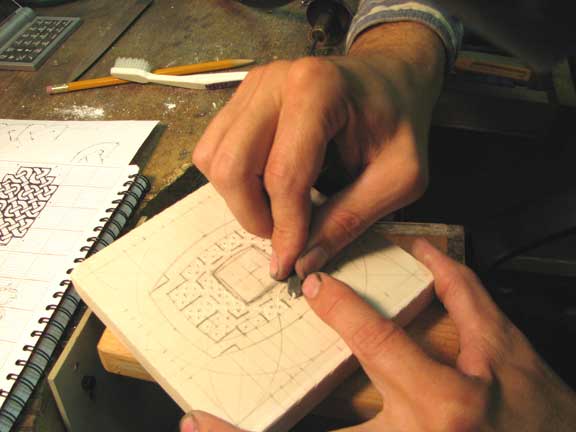|

The Donald MacLeod Memorial Silver
Buckle for 6/8 Marches
The Nicol-Brown Amateur Invitational Piping Contest |
This buckle replaces the original design for the MacLeod Silver
Buckle designed by Brian Yates. I was asked to finish the buckles cast
by Brian for the past several years, but when his castings were all
done, I did not have very good luck with his mold, so was granted
permission to create a new design for the 25th Nicol-Brown Competition.
Other buckles designs by Stephen Walker |
|
 |
The buckle was made by carving a negative mold in a gypsum cement (Ceramical)
The design was laid out using the dot-grid method, most commonly
associated with Aidan Meehan and Mark VanStone. I am convinced that this way of working
in the negative version of the design is how early medieval cast
chip-carving was made. This technique is also referred to as "kerbschnitt"
Not all medieval interlace was made this way. The technique appears to
have been lost before the 11th century. At that time there was a revival
of interlaced designs that were cast using a different method. |
|
 |
The design is gouged out of the mold material. In this case a double
pointed tool is used that results in a double line, raised ridge in the
positive casting. The way this is done, the design is carved deeper
and deeper until all the original surface is removed in the area of the
design. Then the high spots in the mold are points and sharp ridges, but
they are low enough that a flat back on the mold will have some
clearance, leaving enough space to fill with the cast material and make
a complete background. The overs and unders of the design are done last
by scooping a little deeper the grooves that will become the overs
in the positive cast version. |
|
 |
Arcs for the boarders are carved using a compass with a cutting tool
fashioned onto the moving leg. Experience using this method in both
plaster and clay molds has shown that the thin ridges of the design are
prone to damage if multiple impressions are made. In the case of the
MacLeod Buckle I made several wax impressions of the carving and cast
the final piece using the lost wax method from these models and modern
casting equipment and materials. The crispness of the medieval castings
, especially in the deep negative areas leads me to believe that
typically the metal was cast directly into the carved material.
You can see the lost wax casting process
as we do it at Walker Metalsmiths by following this link. |
My research into this method of mold making was presented to the Irish
Medievalists Conference at Saint Mary Immaculate College in Limerick, June 2007.
An earlier paper on the method was can be accessed at
http://celtarts.net/StNinianBrooches.htm




